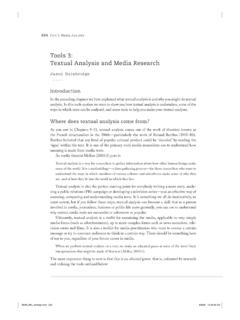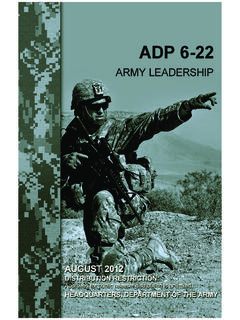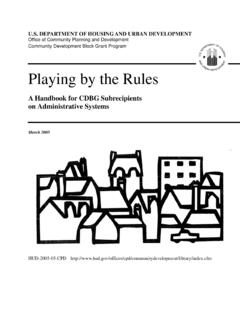Transcription of Public Relations: Strategies and Tactics
1 Public relations : Strategies and Tactics {MITCHELL HOBBS AND ALANA MANN} Mr X thought coal is amazing Mr X was an active member of his community. He had realised many years ago that being a valued member of a community was the secret to a happy life. As such, during the summer Mr X would volunteer to run the canteen at his local cricket club; while in the winter he performed a similar service for his daughter s netball team. His community service extended beyond sporting clubs; Mr X also volunteered as a weekend tour guide at a local museum, and he occasionally assisted with the bookkeeping at his local Surf Life Saving Club. But recently, Mr X had begun to notice an interesting connection between many of the clubs, sports teams, and community facilities present in his city: all seemed to have a connection with one of the three major mining companies that operated in the region. The local sport fields all seemed to be sponsored by mining corporations, as they had large signs acknowledging financial support: The Number 1 Sports Field is Proudly Sponsored by Big Coal, We re Here to Stay.
2 He also noticed that the National Rugby League team and the A-League Football team had Big Coal as their major financial sponsors. Even the Surf Life Saving ca rnival was sponsored by the multinational mining company, Fossil Fuels Unlimited. Reflecting on the generosity by the major mining companies, Mr X was initially rather impressed by their commitment to the community. After all, many of these companies were now multinational corporations headquartered in the United States, and seemed rather removed from his city and his daughter s netball team, which had recently had their new clubhouse painted thanks to a small community grant from one such company. But gradually, Mr X began to wonder why these companies provided such funds to the community what was in it for them? And the more he thought about this question the more he began to notice other Public relations activities that were clearly funded by the mining industry.
3 Billboards at the airport showed happy youthful miners and engineers looking into the sunset or playing on the beach, under the heading: Our Story is Your Story ; conspicuously absent from these billboards was any sign of the gaping hole in the landscape made by an open-cut mine. Mr X had also noticed advertisements on TV and YouTube that celebrated the energy properties of coal, with one advertisement proclaiming: Coal, isn t it amazing . Again, Mr X thought to himself, why spend such large sums on advertisements and community organisations? Was this about image management and promotion, or merely a generous industry sharing some of its profits? Could it perhaps be connected to the battle for Public opinion on the issue of fossil fuels and their connection to anthropogenic climate change? Mr X was starting to question whether the goodwill he felt towards the mining industry might have been engineered by the industry, so that he would vote against politicians calling for new environment reforms.
4 As such, he decided to do a little research into Public relations Strategies and Tactics in order to better understand whether someone was trying to influence his attitude towards this controversial industry. Public relations : Strategies and Tactics 2 Introduction: Public relations and the marketplace of ideas Our twenty-first century society is saturated by media images and information. Media conglomerates, Public service broadcasters, social media, advertisers and others all compete for our attention and limited cogitative capacity. This cornucopia of information and images is empowering, entertaining and informative, and it is the lifeblood of our glittering consumer societies. This system of communication also connects us in ways that were impossible for previous societies. In 1869, the British philosopher John Stuart Mill (1913) wrote that a free society is one in which all individuals can speak and exchange ideas in, what would later be called, a marketplace of ideas (Martinelli, 2011: 34).
5 Today s marketplace of ideas is a crowded place. In order to be heard amidst the cacophony of voices, Public relations specialists use strategic communication to champion and promote the messages and images of their employers. Public relations is a profession dedicated to the effective use of communication . And yet this definition is far too simple as Public relations is so much more than communicating on behalf of corporations, institutions and other organisations. According to Grunig and Hunt (1984: 6) Public relations is about the management of communication between an organisation and its publics . Cutlip et al. (2000: 6) expands on this definition: Public relations is the management function that establishes and maintains mutually beneficial relationships between an organisation and the publics on whom its success or failure depends . Similarly, Harlow (1976: 36) describes the profession as the management function that maintains mutual lines of communication between an organisation and its publics, and which uses research and ethical communication as its principal tools.
6 As these definitions highlight, Public relations is a diverse profession that seeks to ensure that organisations manage their relationships with a variety of stakeholders and broader publics (see Martinelli, 2011: 34). In order to manage the Public image and stakeholder relationships of companies and organisations, Public relations practitioners employ a variety of communication Tactics , including media releases, social media accounts, media events, backgrounders, fact sheets, flyers, pamphlets, annual reports, newsletters, and other materials. Senior practitioners are responsible for planning the details of what, how and why their organisations communicate with strategic publics (Mahoney, 2013: 2). As leaders of a communications team, senior practitioners are often part of an organisation dominant management coalition (that is, its most senior managers) (Mahoney, 2013: 2). These senior practitioners are responsible for protecting the company s Public reputation by identifying issues, and by using effective communication to align the interests of organisations with those of the significant publics in their operating environment (Grunig, Grunig & Dozier 2006: 55).
7 This chapter introduces the profession of Public relations . Rather than providing merely a descriptive account of how to do PR , it offers a critical overview of the profession, including its history, Strategies , Tactics and ethical guidelines. This discussion will provide the reader with a smorgasbord of ideas that can inform best practice within Public relations roles. This chapter also provides several illustrative case studies designed to showcase the diverse activities that a Public relations practitioner undertakes. This discussion begins by considering the historical development of Public relations and its contemporary reach and influence. Mitchell Hobbs and Alana Mann Public relations : Strategies and Tactics 3 Media releases: Media releases are written in an active voice and provide information for news stories. Good media releases conform to journalistic conventions, such as the inverted pyramid of news writing, and answer the standard questions: who, what, when, where, why, and how.
8 Backgrounders: Unlike a media release, a backgrounder is written in chronological order or narrative fashion, and is used to provide important background information to contextualise an event, person, or issue. Fact sheets: As the name suggests, fact sheets are a Public relations tactic used to provide a concise summary of relevant facts that a journalist might include in a news story, such as statistics or a timeline of key events. Public relations : A short history Public relations is commonly considered to be a young profession a type of communications byproduct of twentieth-century capitalism. However, the techniques of organised and persuasive communication are in fact as old as human societies. As Stephen Stockwell (2007: 139) argues, the songs of the shaman were used to unify tribal communities throughout history. Likewise, the ballads of ancient bards preserved the myths and legends that bound together nascent nations (Stockwell, 2007: 139).
9 Yet, perhaps the best historical example of professional communicators is found in ancient Greece, where the Sophists developed and taught the art of rhetoric . According to the great philosopher Aristotle, rhetoric was an important dimension of Public life and Athenian democracy as it allowed assemblies of citizens to debate and then decide what was in their best interests (Stockwell, 2007: 140). These rhetorical exchanges were the essence of their early form of deliberative democracy and are a communicative tradition that continues today in parliaments around the world. Aristotle s writings on rhetoric are the first comprehensive studies of strategic communication and its impacts. While Aristotle recognised that the techniques of rhetoric may be used to manipulate, he believed the free play of communication in the rhetorical field produced a self-correcting mechanism conducive to the production of consensual understandings and truth: [The exchange of rhetoric allows] a contest that brings forth the best among those who offer opposed positions on practical questions [so that] the audience is engaged in such a way that allows it to see more clearly and act more judiciously.
10 (Aristotle cited in Stockwell, 2007: 140). Some of Aristotle s ideas are still seen in the contemporary practices of political Public relations and democratic politics. For instance, Aristotle argued that the elements of persuasive speech are ethos , pathos and logos ( Martinelli, 2011: 34). Ethos refers to the credibility and trustworthiness of the speaker. Pathos refers to rhetorical appeals to emotions and belief systems, and in its modern usage can include the use of stories, inspirational quotes or vivid language. Finally, logos refers to the quality of the logic and reasoning within an argument. All of these dimensions of rhetoric are still considered by contemporary Public relations practitioners when they employ communication campaigns that seek to build support for a particular person or brand, or when using third-party spokespersons for an endorsement (Martinelli, 2011: 34). Mitchell Hobbs and Alana Mann Public relations : Strategies and Tactics 4 While the distant roots of Public relations lie in the art of rhetoric practiced by the ancient Greeks, other notable developments accompanied important political events throughout history.














